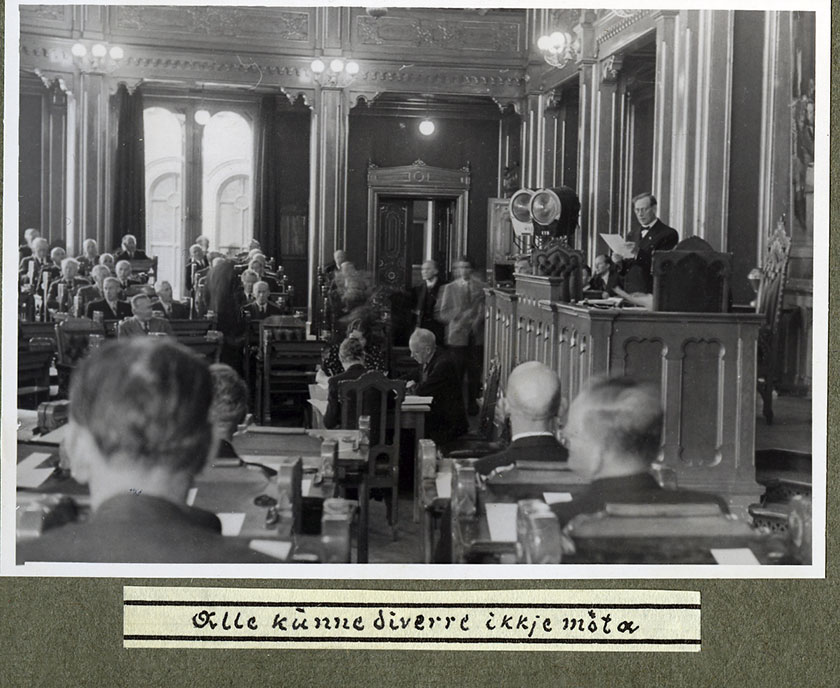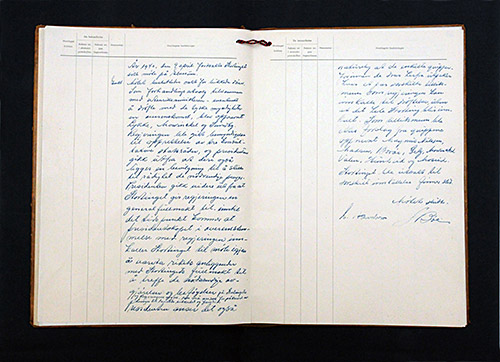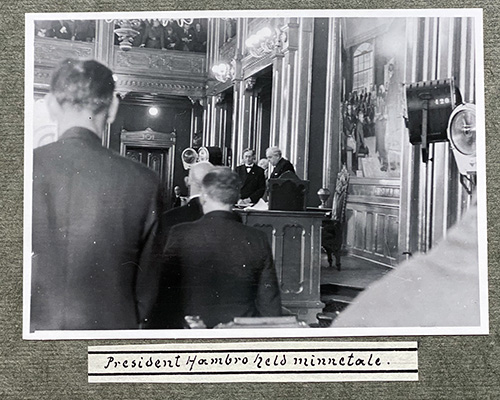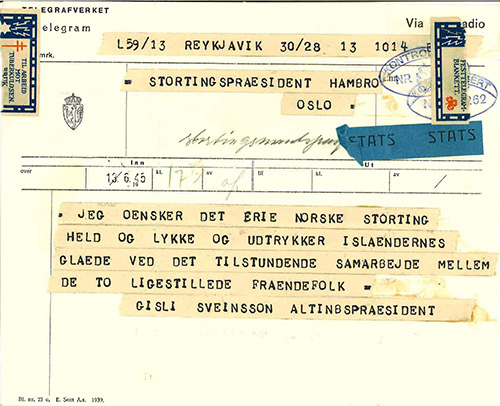
The sitting of the Storting on 14th June 1945. Photo: Karl Korneulissen Kleppe/Storting.
Democracy back in action: the first sitting of the Storting after liberation
Nazi Germany’s invasion of Norway on 9th April 1940 put the Storting out of action. The Elverum Authorization empowered the Government “to safeguard the interests of the realm” until the Storting was next able to sit. But this was not to take place until 14th June 1945, more than a month after World War II ended in Europe.
In its announcement on VE Day, 8th May 1945, the Hjemmefronten (“Home Front”) leadership wrote: “The tasks of war have been resolved; the tasks of peace await. They demand that, together, we do everything in our power to restore our democracy and our rule of law.” So, in the very first hours of liberty, attention was directed towards democracy, the cornerstone of a free and independent Norway.
Divided on how to restore democracy
All agreed that democracy should and must be restored in line with the Norwegian Constitution after over five years of subjugation by war and dictatorship. Exactly how this should be done was another matter, however.
In exile for five years, the Government had been working in the interests of Norway from London. Yet it had not been in the country itself nor taken part in the discussions there. In Norway, the Home Front, and various political groups, whether in freedom or in the prison camps of Grini (Norway) and Sachsenhausen (Germany), had started to plan post-war society.

The Elverum Authorization of 9th April 1940. Photo: Storting.
The Storting had not convened since 9th April 1940. Moreover, the parliamentary term of the Storting that had issued the Elverum Authorization in 1940 had expired in 1941. To compound this, there was considerable dissatisfaction in many circles, in both occupied Norway and from the communities in exile, with the Storting, the remaining members of the Presidium, and how they had acted in the summer of 1940.
During negotiations with the German occupation authorities, the Presidium had allowed itself to be pressured into asking King Haakon VII to abdicate. It had also attempted to withdraw the Elverum Authorization. Both moves had received the backing of a significant number of Members of Parliament (MPs) during German attempts to install a Norwegian government under German occupation, but had been rejected by the King and the Government-in-exile.
For this reason, there were many, not least in the Home Front’s leadership, who believed that the Storting should not convene again until there had been a new parliamentary election. There was also considerable support for those who called for the replacement of the Nygaardsvold Government by a non-parliamentary government originating from the Home Front’s leadership, and with its leader, Paal Berg, as prime minister.
Talks on 4th June 1945 between the returning Government, the Home Front’s leadership, and the Storting’s Presidium resulted in the decision to convene the Storting for a session on 14th June. This outcome was welcomed both at home and abroad.
The Nygaardsvold Government was to be replaced by a parliamentary coalition government under Einar Gerhardsen, but not until the Storting was once again assembled.
14th June – the Storting in session after liberation
On Thursday 14th June, just over five hectic weeks after the liberation of 8th May, Norway’s foremost democratically elected assembly reconvened in a Storting building that had been used and abused by the occupation authorities and Vidkun Quisling’s regime for over five years of war. A building that had been cleaned and made ready once again to host Norway’s elected representatives.

President of the Storting Hambro delivering the memorial address during the Storting’s first sitting on 14th June 1945. Photo: Karl Korneliussen Kleppe/Storting.
The first sitting of 14th June was brief. It began with a memorial address to the nine MPs who had died since the Storting was last in session and, in the words of President of the Storting C.J. Hambro, a tribute to “all those who, during these long years, have given their lives so that we could live.” Hambro also thanked Norway’s allies, and reminded those listening that the nation was still at war and that Norwegian sailors remained in active service on the side of the Allies.
The memorial address was followed by a sitting behind closed doors. Among the items on the order of business was how the Storting should handle and possibly publish the minutes and reports from the National Council negotiations in 1940.
After the in-camera sitting was concluded, it was time for the second open sitting of the day. The most pressing item on the agenda was the formalities, in particular the election of a new Presidium. The five members of the Presidium who had negotiated with the German invaders in 1940 tendered their resignations out of consideration for the investigation that would come regarding their conduct at the time. This meant that the only member of the Presidium to be re-elected was President of the Storting Hambro.
Three short sessions for the old Storting
Because of the war, the Storting term that commenced in 1936 became the longest in history. Three short parliamentary sessions were held from 14th June 1945 until the autumn of the same year. During these, the Storting dealt with matters that were instrumental for keeping the wheels of peacetime Norway in motion. Measures were passed – economic, social, and political – to return society to normal as quickly as possible. Not least, it was imperative that parliamentary and local government elections should be held. In November, the Storting approved Norway’s entry into the United Nations (UN), the new world organization.

During the first sitting, the President of the Storting read out a greeting telegram from Gisli Sveinsson, the President of the Icelandic Parliament. Photo: Storting.
It was also necessary to discuss and debate questions that had emerged during the war, and which had been dealt with by the Government in London by decree. Some of these questions were, quite literally, about life and death; about the death penalty and treason, and how to deal with Norwegian collaborators and traitors. Many related to the finances of the state. Others would appear as curiosities today, such as the repeal of the Bigamy Act, passed in 1942 to allow Norwegians living abroad to remarry even though the war prevented them from divorcing their spouses in occupied Norway.
The resumption of democratic life after the occupation also provided the opportunity for important reform in other areas. One such milestone saw the lowering of the voting age to 21 for local government elections, a demand from several different quarters based on the conduct and active efforts of young people during the war.
Norway’s longest electoral term comes to an end
A parliamentary election was held on 8th October 1945. After a number of sittings in November, the 89th Storting convened for the last time on 24th November. In his final speech, President of the Storting Hambro thanked the Members of Parliament for having done their best over the past nine years, and concluded with the following words: “Against its wish and will, this Storting has had a longer term of office than any previous Storting.”
A week and a half later, on 4th December 1945, the 90th ordinary Storting convened for the first time.
Last updated: 07.05.2025 15:23